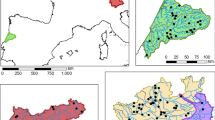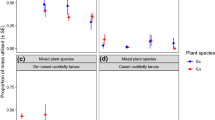Abstract
Dispersal is a pivotal process in ecology since it determines species presence across patches in landscapes. Therefore, understanding dispersal may be critical in light of current environmental changes. Here, we conducted an experiment to evaluate how richness, density, and β-diversity of insects with strong and/or weak aquatic and aerial dispersal abilities are influenced by colonization limitation of aerial and aquatic patches of a floating macrophyte. We used nets to isolate the aquatic (by roots) and aerial (by leaves) routes by which insects may colonize floating macrophytes. We found that strong aquatic and aerial dispersers were not affected by colonization limitation, since the richness and density of these groups did not decrease with limited colonization. Conversely, limited colonization resulted in a strong decrease in the richness and density of weak aquatic and aerial dispersers. Also, the beta diversity of weak dispersers strongly increased with limited colonization, whereas strong dispersers produced more homogeneous communities (low beta diversity). Our findings illustrate that increasing habitat fragmentation and destruction should have stronger impacts on weak dispersers as they are not able to overcome the habitat scarcity. Consequently, only strong dispersers may persist, leading to high community similarity.





Similar content being viewed by others
References
Anderson MJ, Ellingsen KE, McArdle BH (2006) Multivariate dispersion as a measured of beta diversity. Ecol Lett 9:683–693
Bacles CFE, Lowe AJ, Ennos RA (2006) Effective seed dispersal across a fragmented landscape. Science 331:628–628
Bilton DT, Freeland JR, Okamura B (2001) Dispersal in freshwater invertebrates. Annu Rev Ecol Evol S 32:159–181
Bowler DE, Benton TG (2005) Causes and consequences of animal dispersal strategies: relating individual behavior to spatial dynamics. Biol Rev 80:204–225
Brederveld RJ, Jähnig SC, Lorenz AW, Brunzel S, Soons MB (2011) Dispersal as a limiting factor in the colonization of restored mountain streams by plants and macroinvertebrates. J Appl Ecol 48:1241–1250
Brown BL, Swan CM (2010) Dendritic network structure constrains metacommunity properties in riverine ecosystems. J Anim Ecol 79:571–580
Bulla CK, Gomes LC, Miranda LE, Agostinho AA (2011) The ichthyofauna of drifting macrophyte mats in the Ivinhema River, upper Paraná River basin. Braz Neotrop Ichthyol 9(2):403–409
Butakka CMM, Ragonha FH, Train S, Pinha GD, Takeda AM (2016) Chironomidae feeding habits in different habitats from a Neotropical floodplain: exploring patterns in aquatic food webs. Braz J Biol 76:117–125
Campos R, Lansac-Tôha FM, Conceição EO, Martens K, Higuti J (2018) Factors affecting the metacommunity structure of periphytic ostracods (Crustacea, Ostracoda): a deconstruction approach based on biological traits. Aquat Sci 80:16
Castillo-Escrivá A, Aguilar-Alberola JA, Mesquita-Joanes F (2017) Spatial and environmental effects on a rock-pool metacommunity depend on landscape setting and dispersal mode. Freshw Biol 62:1004–1011
De Bie T, De Meester L, Brendonck L, Martens K, Goddeeris B, Ercken D, Hampel H, Denys L, Vanhecke L, Van der Gucht L, Van Wichelen J, Vyverman W, Declerck SAJ (2012) Body size and dispersal mode as key traits determining metacommunity structure of aquatic organisms. Ecol Lett 15:740–747
Domínguez E, Fernández HR (2009) Macroinvertebrados bentónicos sudamericanos. Sistemática y biología. Fundación Miguel Lillo, Tucumán
Ewers RM, Didham RK (2006) Confounding factors in the detection of species responses to habitat fragmentation. Biol Rev 81:117–142
Gotelli NJ, Colwell RK (2001) Quantifying biodiversity: procedures and pitfalls in the measurement and comparison of species richness. Ecol Lett 4:379–391
Grönroos M, Heino J, Siqueira T, Landeiro VL, Kotanen J, Bini LM (2013) Metacommunity structuring in stream networks: roles of dispersal model, distance type, and regional environmental context. Ecol Evol 13:4473–4487
Heino J (2013) Does dispersal ability affect the relative importance of environmental control and spatial structuring of littoral macroinvertebrate communities? Oecologia 171:971–980
Heino J, Grönroos M, Soininen J, Virtanen R, Muotka T (2012) Context dependency and metacommunity structuring in boreal headwater streams. Oikos 121:537–544
Heino J, Melo AS, Siqueira T, Soininen J, Valanko S, Bini LM (2015) Metacommunity organisation, spatial extent and dispersal in aquatic systems: patterns, process and prospects. Freshw Biol 60:845–869
Heino J, Alahuhta J, Ala-Hulkko T, Antikainen H, Bini LM, Bonada N, Datry T, Erős T, Hjort J, Kotavaara O, Melo AS, Soininen J (2017) Integrating dispersal proxies in ecological and environmental research in the freshwater realm. Environ Rev 25:334–349
Hothorn T, Bretz F, Westfall P (2008) Simultaneous inference in general parametric models. Biom J 3:346–363
Kneitel JM (2018) Occupancy and environmental responses of habitat specialists and generalists depend on dispersal traits. Ecosphere 9:1–11
Kouamé MK, Diétoa MY, Da Costa SL, Edia EO, Ouattara A, Gourene G (2010) Aquatic macroinvertebrate assemblages associated with root masses of water hyacinths, Eichhornia crassipes (Mart.) Solms-Laubach, 1883 (Commelinales: Pontederiaceae) in Taabo Lake. Ivory Coast J Nat Hist 44:257–278
Kraft NJB, Comita LS, Chase JM, Sanders NJ, Swenson NG, Crist TO, Stegen JC, Vallend M, Boyle B, Anderson MJ, Cornell HV, Davies KF, Freestone AL, Inouye BD, Harrison SP, Myers JA (2011) Disentangling the drivers of β diversity along latitudinal and elevation gradients. Science 333:1755–1758
Leibold MA, Holyoak M, Mouquet N, Amarasekare P, Chase JM, Hoopes MF, Holt RD, Shurin JB, Law R, Tilman D, Loreau M, Gonzalez A (2004) The metacommunity concept: a framework for multi-scale community ecology. Ecol Lett 7:601–613
Li F, Tonkin JD, Haase P (2020) Local contribution to beta diversity is negatively linked with community-wide dispersal capacity in stream invertebrate communities. Ecol Indic 108:105715
Logue JB, Mouquet N, Peter H, Hillebrand H, MW Group (2011) Empirical approaches to metacommunities: a review and comparison with theory. Trends Ecol Evol 26:482–491
Melero Y, Stefanescu C, Palmer SCF, Travis JMJ, Pino J (2020) The role of the urban landscape on species with contrasting dispersal ability: Insights from greening plans for Barcelona. Landsc Urban Plan 195:103707
Merritt RW, Cummins KW, Berg MB (2008) An introduction to the aquatic insects of North America. Kendall/Hunt Publishing Company, Dubuque
Moi DA, Romero GQ, Antiqueira PAP, Mormul RP, Teixeira de Mello F, Bonecker CC (2021) Multitrophic richness enhances ecosystem multifunctionality of tropical shallow lakes. Funct Ecol 35:942–954
Morin A, Stephenson J, Strike J (2004) Sieve retention probabilities of stream benthic invertebrates. J N Am Benthol Soc 23:383–391
Mormul RP, Thomaz SM, Takeda AM, Behrend RD (2011) Structural complexity and distance from source habitat determine invertebrate abundance and diversity. Biotropica 43:738–745
Mouquet N, Loreau M (2002) Coexistence in metacommunities: the regional similarity hypothesis. Am Nat 159:420–426
Mouquet N, Loreau M (2003) Community patterns in source-sink metacommunity. Am Nat 162:544–557
Oksanen J, Blanchet FG, Kindt R, Legendre P, Minchin PR, O´Hara RB, Simpson GL, Solymos P, Stevens MHH, Szoecs E, Wagner H (2017) Package ‘Vegan’. Community ecology package, version 2. http://CRAN.R-project.org/package=vegan
Parain EC, Gray SM, Bersier LF (2019) The effects of temperature and dispersal on species diversity in natural microbial metacommunities. Sci Rep 9:18286
Petersen I, Masters Z, Hildrew AG, Ormerod SJ (2004) Dispersal of adult aquatic insects in catchments of differing land use. J Appl Ecol 41:934–950
Poff NL (1997) Landscape filters and species traits: towards a mechanistic understanding and prediction in stream ecology. J N Am Benthol Soc 16:391–409
Poff NL, Olden JD, Vieira NKM, Finn DS, Simmons MP, Kondratieff BC (2006) Functional trait niches of North American lotic insects: traits-based ecological applications in light of phylogenetic relationships. J N Am Benthol Soc 25:730–755
R Core Team. 2017. R: a language and environment for statistical computing. R Foundation for Statistical Computing.
Recalde FC, Breviglieri CPB, Romero GQ (2020) Allochthonous aquatic subsidies alleviate predation pressure in terrestrial ecosystems. Ecology 101:e03074
Reinhardt K, Köhler G, Mass S, Detzel P (2005) Low dispersal ability and habitat specificity promote extinctions in rare but not in widespread species: the Orthoptera of Germany. Ecography 28:593–602
Resetarits W, Silberbush A (2016) Local contagion and regional compression: habitat selection drives spatially explicit, multiscale dynamics of colonization in experimental metacommunities. Ecol Lett 19:191–200
Rocha-Ramirez A, Ramirez-Rojas A, Chavez-Lopez R, Alcocer J (2007) Invertebrate assemblages associated with root masses of Eichhornia crassipes (Mart.) Solms-Laubach 1883 in the Alvarado Lagoonal System, Veracruz. Mexico Aquat Ecol 41:319–333
Romero GQ, Moi DA, Nash LN, Antiqueira PAP, Mormul RP, Kratina P (2021) Pervasive decline of subtropical aquatic insects over 20 years driven by water transparency, non-native fish and stoichiometric imbalance. Biol Lett 17:20210137
Shurin JB, Cottenie K, Hillebrand H (2009) Spatial autocorrelation and dispersal limitation in freshwater organisms. Oecologia 159:151–159
Smith RF, Venugopal PD, Baker ME, Lamp WO (2015) Habitat filtering and adult dispersal determine the taxonomic composition of stream insects in an urbanizing landscape. Freshw Biol 60:1740–1754
Stoll S, Kail J, Lorenz AW, Sundermann A, Haase P (2014) The importance of the regional species pool, ecological species traits and local habitat conditions for the colonization of restored river reaches by fish. PLoS ONE 9:e84741
Taniguchi H, Nakano S, Tokeshi M (2003) Influences of habitat complexity on the diversity and abundance of epiphytic invertebrates on plants. Freshw Biol 48:718–728
Thomaz SM, Cunha ER (2010) The role of macrophytes in habitat structuring in aquatic ecosystems: methods of measurement, causes and consequences on animal assemblages’ composition and biodiversity. Acta Limnol Bras 22:218–236
Thomaz SM, Dibble ED, Evangelista LR, Higuti J, Bini LM (2008) Influence of aquatic macrophyte habitat complexity on invertebrate abundance and richness in tropical lagoons. Freshw Biol 53:358–367
Vannette RL, Fukami T (2017) Dispersal enhances beta diversity in nectar microbes. Ecol Lett 20:901–910
Vellend M, Srivastava DS, Anderson KM, Brown CD, Jankowski JE, Kleynhans EJ, Kraft NJB, Letaw AD, Macdonald AAM, Maclean JE, Myers-Smith IH, Norris AR, Xue X (2014) Assessing the relative importance of neutral stochasticity in ecological communities. Oikos 123:1420–1430
Washko S, Bogan MT (2019) Global patterns of aquatic macroinvertebrate dispersal and functional feeding traits in arid land rock pools. Front Environ Sci 7:106
Whatley MH, van Loon EE, Vonk JA, van der Geest HG, Admiraal W (2014) The role of emergent vegetation in structuring aquatic insect communities in peatland drainage ditches. Aquat Ecol 48:267–283
Wilson MJ, McTammany ME (2016) Spatial scale and dispersal influence metacommunity dynamics of benthic invertebrates in a large river. Freshw Sci 35:738–747
Acknowledgements
We are very grateful to Claudia C. Bonecker for the revision of the manuscript. This study was financed in part by the Coordenação de Aperfeiçoamento de Pessoal de Nível Superior—Brasil (CAPES)—Finance Code 001 (scholarships to R.G.R. and D.A.M.). R.P.M. and A.S.M. are thankful for the constant funds and productivity grants received from the Conselho Nacional de Desenvolvimento Científico e Tecnológico (CNPq) (projects 307587/2017-7 and 436049/2018-0 to A.S.M. and 302798/2019-6 to R.P.M.).
Author information
Authors and Affiliations
Corresponding author
Additional information
Handling Editor: Jamie Kneitel.
Publisher's Note
Springer Nature remains neutral with regard to jurisdictional claims in published maps and institutional affiliations.
Rights and permissions
About this article
Cite this article
García-Ríos, R., Moi, D.A., Melo, A.S. et al. Insect dispersal ability is crucial to overcome limitations in patch colonization of Eichhornia crassipes floating meadows. Limnology 23, 287–298 (2022). https://doi.org/10.1007/s10201-021-00688-6
Received:
Accepted:
Published:
Issue Date:
DOI: https://doi.org/10.1007/s10201-021-00688-6




